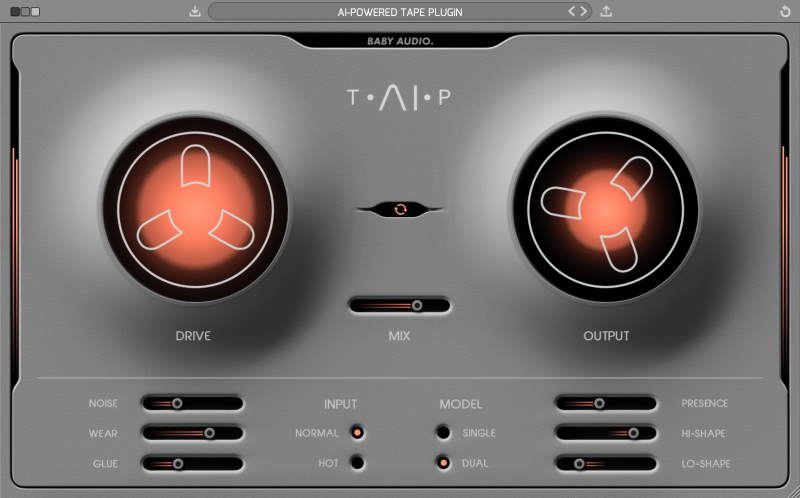TAIP - New Tape Saturation Plugin from BABY Audio

Software developer Baby Audio has released TAIP, an AI-powered tape emulation plugin. Tape recordings have a musical quality that digital mixes often lack. TAIP brings this quality into the DAW. The plugin will add some authentic analog heat – without the need to route any audio outside the box.
Tape plugins are not a new concept. However, Baby Audio’s emulation method is. Instead of using traditional DSP, Baby Audio has developed TAIP around an AI algorithm designed to decipher the invisible nuances of analog circuits. The result is a truly faithful tape emulation that’s intuitive and creative in use – with some added features to accommodate a modern workflow. Use TAIP to bring a touch of warmth and glue, or ‘drive it like you hate it’ as an alternative to distortion plugins.
Highlights
- AI-powered algorithm, giving users the true warmth and behavior of analog tape
- Flexible feature set, allowing users to create a custom ‘tape flavor’ for any need
- TAIP adds a musical saturation and glue to drums, instruments, vocals and beyond
- Read more about the feature set and Baby Audio’s AI emulation approach further below
Presets
- TAIP comes loaded with 135 presets created by friends of BABY Audio - including:
- Mark Needham (Fleetwood Mac, The Killers, Bloc Party, Elton John)
- Max Jaeger (Ariana Grande, Kanye West, Drake, Calvin Harris)
- Eestbound (Travis Scott, Young Thug, Jazz Cartier)
- Rob Kleiner (Sia, Britney Spears, David Guetta, Cee Lo)
- Cesar Sogbe (Prince, David Byrne, Jennifer Lopez)
Display Options
- Switch between three backgrounds (Black / Gray / White)
- Plugin window fully resizable
Features
TAIP is Baby Audio's attempt at creating the ideal ‘Tape Machine’ for the DAW-era, combining an authentic vintage sound with a modern feature set. Its parameters will let you customize the right tape flavor for any need.
- DRIVE: Traditionally, tape machines were designed to color the sound as little as possible. TAIP is not. You can use the DRIVE knob to add just as much color as you need - from a subtle touch of heat to heavy distortion.
- MIX/TAPE FLANGING: MIX lets you run your tape in parallel. You can combine MIX and WEAR to get a classic ‘tape flanging’ effect. This is caused by the wow and flutter of WEAR running in parallel with the dry track.
- MODEL: While SINGLE is a regular tape emulation, DUAL creates a series of two tape emulations chained together under the hood, each applying half of the DRIVE value. This will add slightly more weight to your signal.
- LO-SHAPE / HI-SHAPE: These sliders let you saturate the low/high end more or less than the rest of the frequency spectrum. (Example: Warm up a drum buss without distorting the low frequencies).
- GLUE: Tape machines are known to introduce a pleasing compression-like effect due to their low dynamic range. TAIP lets you add this effect – or even exaggerate it. Use GLUE for subtle cohesion or as an actual compressor.
- NOISE: Lets you add tape noise to taste – or avoid it altogether.
- WEAR: Combines wow, flutter and an altered frequency response curve to emulate a worn-out tape machine.
- PRESENCE: Part of the tape warmth comes from an attenuated high-end. PRESENCE allows you to decide how much of that attenuation you want. It can bring back the brightness that is sometimes lost on tape.
- INPUT: Choose between NORMAL or HOT (more distorted) input levels without affecting the output volume.
- AUTO GAIN: Allows you to add more DRIVE while keeping a consistent plugin output level.
‘AI’ is an overused - and often misused - term. But we believe it’s the future of music technology. It just needs to be used genuinely and with a legitimate purpose.
For a hardware emulation project like TAIP, AI offers an alternative - and in our opinion more faithful - approach over the traditional DSP method. Where a normal DSP emulation would entail ‘guesstimating’ the effect of various analog components and their mutual dependencies, we can use AI / neural networks to accurately decipher the sonic qualities that make a tape machine sound and behave in the way it does. This happens by feeding an algorithm various training data of dry vs. processed audio and teaching it to identify the exact characteristics that make up the difference. Once these differences have been learned by the AI, we can apply them to new audio.
This process may sound overly digital for a plugin that brings an analog sound. But the reality is that ‘analog’ and ‘digital’ are two fundamentally different domains. To get a computer to behave (or sound!) in a certain way, it helps to think like it does. Re-creating an ‘analog-style’ signal path in DSP is thinking about the problem like a human. The AI approach helps us solve the problem like a machine would – for a more faithful emulation.